
The single most important factor on the form of a lava flow is probably the effusion rate, or rate of discharge, measured in cubic meters per second. The higher the effusion rate, the greater the distance traveled before cooling lowers the viscosity and impedes flow. The effusion rates for andesite to dacite lavas (10 to 0.05 cubic meters per second) are a few orders of magnitude lower than those for basalt (0.5 to 5000 cubic meters per second). Thus, basalt lavas are generally much more extensive than the more felsic rock types. Basaltic lavas extruded at relatively low effusion rates generally produce a number of small flow units extruded closely in time so that they overrun each other in anastomising channels. Upon cooling, these flow units produce compound flows. Basalt lavas with higher effusion rates, however, produce extensive flows, often extruded as large-volume flowsheets. These flows are composed of a single cooling unit and are called simple flows. The high effusion rates associated with flood basalt provinces suggest that they contain large-volume simple flows.
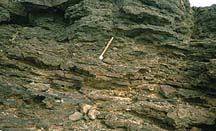 |
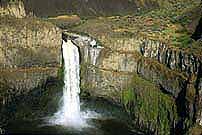
|
|
|
|
As a lava flow cools and crystallizes into a coherent rock, it begins to contract. Shrinkage of the rock mass results in the development of numerous cracks, called joints. Although lava flows can display a variety of jointing patterns, many of the thicker simple flows exhibit a three-tiered character: from bottom to top, a lower colonade, a middle entablature, and an upper colonade. The lower colonade is composed of columnar joints, which develop perpendicular to the cooling surface, at the base of the flow, where they intersect to form a series of columns. The columns may vary in length from one to five meters, with diameters that are generally less than one meter. Each column is polygonal in cross-section (typically hexagonal) and bounded by 4-to-8 joints. If present, the entablature is composed of an array of closely spaced, subvertical joints, which forms a more convoluted pattern of cracks known as hackly jointing. The upper colonade is generally poorly develped or non-existent. If present, the crude columnar joints are vesicular and much shorter than those displayed in the lower colonade.
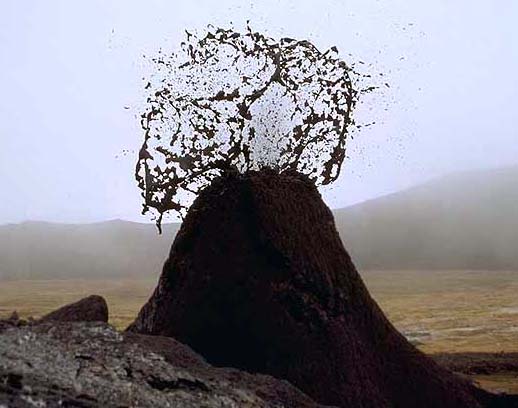
|
Jointing in basalt -- This lava flow from the Staffa, Scotland exhibits a well-developed lower colonade and a hackly jointed entablature. |
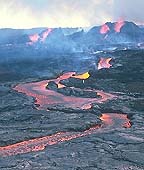 Although highly effusive eruptions may
advance downslope as massive sheets of basaltic lava, such flows
are rare in the historic record. Fluid basalt will more commonly
move down slope by creating its own channelways above gently sloping
terrains, or by flowing down in pre-existing stream channels.
A well-developed lava channel is shown here near a series of eruptive
vents on the northeast rift zone of the Mauna
Loa Volcano, Hawaii. Lava channels can develop in both
pahoehoe and a'a basalt. Once established, lava channels
will often develop lava
levees along their lengths. In pahoehoe flows,
natural levees will be constructed as the channel periodically
overflows, thus allowing the lava to congeal and cool along the
banks of the channel. In a'a flows, levee buildup can also occur
by the bulldozing effect of the moving lava, which will push a'a
blocks onto the lava banks. Although lava channels may initially
be restricted to a topographic valley, as levees build up over
time, they may eventually rise above the surrounding ground surface.
Sometimes
several small lava channels will flow around subdued hills or
high ground to produce a kipuka,
an Hawaiian term for "island." In Hawaii, these features
are generally noted by their mature vegetation, which stands in
contrast to the stark lack of vegetation in the younger, surrounding
basalt flows.
Although highly effusive eruptions may
advance downslope as massive sheets of basaltic lava, such flows
are rare in the historic record. Fluid basalt will more commonly
move down slope by creating its own channelways above gently sloping
terrains, or by flowing down in pre-existing stream channels.
A well-developed lava channel is shown here near a series of eruptive
vents on the northeast rift zone of the Mauna
Loa Volcano, Hawaii. Lava channels can develop in both
pahoehoe and a'a basalt. Once established, lava channels
will often develop lava
levees along their lengths. In pahoehoe flows,
natural levees will be constructed as the channel periodically
overflows, thus allowing the lava to congeal and cool along the
banks of the channel. In a'a flows, levee buildup can also occur
by the bulldozing effect of the moving lava, which will push a'a
blocks onto the lava banks. Although lava channels may initially
be restricted to a topographic valley, as levees build up over
time, they may eventually rise above the surrounding ground surface.
Sometimes
several small lava channels will flow around subdued hills or
high ground to produce a kipuka,
an Hawaiian term for "island." In Hawaii, these features
are generally noted by their mature vegetation, which stands in
contrast to the stark lack of vegetation in the younger, surrounding
basalt flows.
One characteristic of a'a channels is the occurrence of nearly spherical masses of lava with diameters of a few inches to over ten feet. These features are called accretionary lava balls. When broken apart, they reveal a spiral structure which appears to form when a small fragment of solidified lava rolls along the surface of an a'a flow. The lava then adheres to the rolling mass, much like snow sticks to a rolling snowball.
|
|
|
|
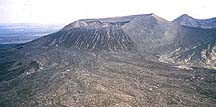 It is not unusual for lava to accumulate
in volcanic craters, filling the craters to a high level to generate
lava lakes.
If the effusion rate is constant and high, the lava may rise above
the crater rim, breaching the crater and spilling out onto the
adjacent surface. One example of this is the Kupaianaha
lava lake in Hawii, which overtopped it's crater in 1986.
A much older example shown in the image to the left. This is the
Jabal Hil
scoria cone, located on
the Harrat Kishb lava field, about 150 kilometers northeast of
Mecca in western Saudi Arabia. The Jabal Hil flow field is Post-Neolithic
in age and composed of anastomosing pahoehoe
and a'a lava
flows that have cascaded down from the crater rim due to overspilling
of a crater lake.
It is not unusual for lava to accumulate
in volcanic craters, filling the craters to a high level to generate
lava lakes.
If the effusion rate is constant and high, the lava may rise above
the crater rim, breaching the crater and spilling out onto the
adjacent surface. One example of this is the Kupaianaha
lava lake in Hawii, which overtopped it's crater in 1986.
A much older example shown in the image to the left. This is the
Jabal Hil
scoria cone, located on
the Harrat Kishb lava field, about 150 kilometers northeast of
Mecca in western Saudi Arabia. The Jabal Hil flow field is Post-Neolithic
in age and composed of anastomosing pahoehoe
and a'a lava
flows that have cascaded down from the crater rim due to overspilling
of a crater lake.
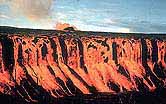 |
As lava descends down an irregular topographic surface it will occasionally flow over an abrupt escarpment to produce lava cascades, or lava falls, such as those shown here. |
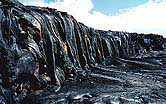 |
As the effusive rate decreases, and the lava begins to cool, the basalt may solidify in place to cover the escarpment in an apron of crystalline rock, called a lava drapery. |
On flat or gentle
slopes, the surfaces of pahoehoe flows are sometimes marked by
elliptical domed structures, from 2 to 10 meters high, called
tumuli. These are best developed
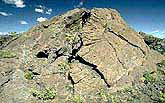 on the surface of flows that are ponded
in depressions, like craters or calderas. A tumulus develops when
slow-moving lava beneath a solidified crust wells upward. The
brittle crust usually buckles to accommodate the inflating core
of the flow, thus creating a central crack along the length of
the tumulus. These structures sometimes grade into elongate forms
called pressure ridges, which commonly develop subparallel
to the flow direction at flow margins, but perpendicular to the
flow direction in the central portions of the flow. Localized
upheaval of the underlying lava to produce tumuli can result from
a variety of mechanisms, including (a) obstruction of lateral
flow downstream behind a slow-moving lava front, (b) diversion
of flow upward against an irregular topographic surface, (c) local
upheaval from the volatilization of groundwater, and (d) deflation
of an inflated
pahoehoe
sheet flow leading to differential sagging and crustal buckling.
on the surface of flows that are ponded
in depressions, like craters or calderas. A tumulus develops when
slow-moving lava beneath a solidified crust wells upward. The
brittle crust usually buckles to accommodate the inflating core
of the flow, thus creating a central crack along the length of
the tumulus. These structures sometimes grade into elongate forms
called pressure ridges, which commonly develop subparallel
to the flow direction at flow margins, but perpendicular to the
flow direction in the central portions of the flow. Localized
upheaval of the underlying lava to produce tumuli can result from
a variety of mechanisms, including (a) obstruction of lateral
flow downstream behind a slow-moving lava front, (b) diversion
of flow upward against an irregular topographic surface, (c) local
upheaval from the volatilization of groundwater, and (d) deflation
of an inflated
pahoehoe
sheet flow leading to differential sagging and crustal buckling.
Rootless eruptions
are not connected at depth to a magma chamber, but rather result
from surface eruptions on pahoehoe surfaces. When the pahoehoe
crust thickens and the underlying lava becomes cool, viscous,
and gas-depleted, pasty 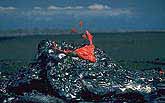 lava can squeeze up through
the axial fracture of the tumulus like cold toothpaste. This process
creates a protrusion of cheesy basalt commonly called a squeeze-up.
Squeeze-ups can occur as bulbous mounds on pahoehoe surfaces,
or as linear wedges in the axial core of tumuli. It the lava remains
hot and liquid, local extrusions through the cracked pahoehoe
surfaces can produce rootless cones of spatter, called hornitos, or driblet cones. Such
features can erupt through the axial cracks of tumuli as well
as through cracks and openings overlying active lava tubes.
lava can squeeze up through
the axial fracture of the tumulus like cold toothpaste. This process
creates a protrusion of cheesy basalt commonly called a squeeze-up.
Squeeze-ups can occur as bulbous mounds on pahoehoe surfaces,
or as linear wedges in the axial core of tumuli. It the lava remains
hot and liquid, local extrusions through the cracked pahoehoe
surfaces can produce rootless cones of spatter, called hornitos, or driblet cones. Such
features can erupt through the axial cracks of tumuli as well
as through cracks and openings overlying active lava tubes.
The chilling and crystallization of basaltic lava around the sides, bottom, and top of lava channels produces a rock-encased conduit called a lava tube. The surrounding crystalline basalt remains relatively hot and insulates the interior lava in the lava tube from further crystallization. Although lava tubes are generally restricted to pahoehoe lava flows, they can form in some thick a'a flows, like those that occur on Mt. Etna. The tube morphology provides a very efficient mechanism for basaltic lava flows to travel great distances away from their source without significant heat loss. Their lateral extents are highly variable. Although lava tubes are typically < 1 km long, they may exceed several kilometers, as demonstrated, for example, by a lava tube in Queensland, Australia that is > 100 km long. The diameters of lava tubes are also highly variable, from < 1m to as much as 15m.
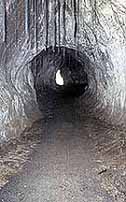 High
lava temperatures of about 1150 degrees Centigrade (~ 2100 degrees
Fahrenheit) are maintained throughout the tube system. These high
temperatures allow the lava to remain very fluid. The high fluidity
of lava in lava tubes and lava channels leads to high transport
rates. During the 1984 eruption of Mauna Loa, for example, channel
flow was measured by USGS volcanologists at 35 mph. Lava speeds
within the current tube system associated with the Pu'u
O'o eruption
have been measured up to 23 mph. This fast moving, turbulent lava,
combined with the high lava temperatures, can result in thermal
erosion of the tube interior. Once established, well-insulated
lava tubes can thus erode both downward and laterally over time.
The turbulence from fluid motion and from constantly escaping
gases generates spatter fragments that coat the walls of many
lava tubes. Eventually, the eruption will cease and the remaining
lava in the tube will drain downslope to expose a hollow, inactive
lava tube. Such tubes typically contain a flat floor and exhibit
high-lava marks on the conduit walls. A thin coating of agglutinated
spatter
is often found on the tube walls, together with icicle-shaped
lava stalactites hanging from the roof. Mound-like
lava stalagmites derived from spatter dripping onto
the floor of tubes are less common. The example shown here is
the well-known Thurston lava tube near the Kilauea
summit caldera in Hawaii Volcanoes National
Park (Photo courtesy of the USGS).
High
lava temperatures of about 1150 degrees Centigrade (~ 2100 degrees
Fahrenheit) are maintained throughout the tube system. These high
temperatures allow the lava to remain very fluid. The high fluidity
of lava in lava tubes and lava channels leads to high transport
rates. During the 1984 eruption of Mauna Loa, for example, channel
flow was measured by USGS volcanologists at 35 mph. Lava speeds
within the current tube system associated with the Pu'u
O'o eruption
have been measured up to 23 mph. This fast moving, turbulent lava,
combined with the high lava temperatures, can result in thermal
erosion of the tube interior. Once established, well-insulated
lava tubes can thus erode both downward and laterally over time.
The turbulence from fluid motion and from constantly escaping
gases generates spatter fragments that coat the walls of many
lava tubes. Eventually, the eruption will cease and the remaining
lava in the tube will drain downslope to expose a hollow, inactive
lava tube. Such tubes typically contain a flat floor and exhibit
high-lava marks on the conduit walls. A thin coating of agglutinated
spatter
is often found on the tube walls, together with icicle-shaped
lava stalactites hanging from the roof. Mound-like
lava stalagmites derived from spatter dripping onto
the floor of tubes are less common. The example shown here is
the well-known Thurston lava tube near the Kilauea
summit caldera in Hawaii Volcanoes National
Park (Photo courtesy of the USGS).
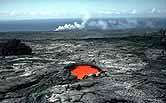 Because lava tubes remain
buried, they often go unrecognized on the surface. However, many
lava tubes are delineated on the surface by a linear or curvilinear
series of collapse depressions, called skylights along the axis of the
tube. On active lava tubes, skylights provide a unique view of
actively flowing incandescent lava in the lava tube system. The
example shown here from a skylight developed above an active lava
tube associated with the Kupaianaha eruption in 1989 on the east
rift system of the larger Kilauea volcano, Hawaii.
Because lava tubes remain
buried, they often go unrecognized on the surface. However, many
lava tubes are delineated on the surface by a linear or curvilinear
series of collapse depressions, called skylights along the axis of the
tube. On active lava tubes, skylights provide a unique view of
actively flowing incandescent lava in the lava tube system. The
example shown here from a skylight developed above an active lava
tube associated with the Kupaianaha eruption in 1989 on the east
rift system of the larger Kilauea volcano, Hawaii.
See also: